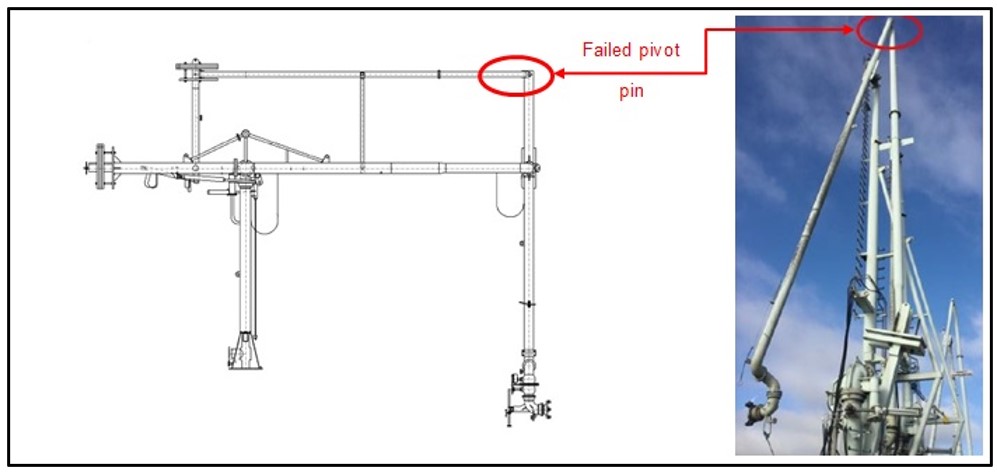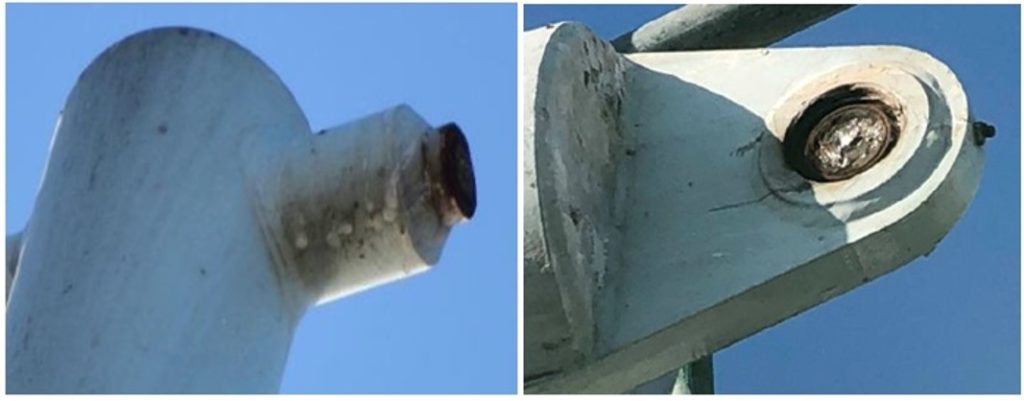HSE: Catastrophic failure of marine loading arm
What happened
The UK Health and Safety Executive (HSE) has published a safety alert on the catastrophic failure of a marine loading arm. Marine loading arms (MLAs) are used to transfer material from ship to shore. Full alert found here.
This safety alert is aimed at users and companies that service MLAs to ensure they carry out suitable and sufficient inspection and maintenance to help avoid similar incidents. It has wider applicability to all lifting equipment
What went wrong?
The MLA failed as it was being manoeuvred towards a ship manifold for connection. A section of the MLA fell backwards onto a jetty handrail narrowly avoiding live plant and pipework. This hydraulically operated MLA had been in service for 11 years and had been regularly maintained by various recognised industry contractors. It had a rigid link pantograph balancing system with independent primary and secondary counterweights linked to the inboard and outboard arms.


What was the cause?
Investigation found that a failed pantograph pivot pin led to the resulting collapse of the arm.
The immediate cause of the failure was from corrosion of the bearing that led to a complete fracture, emanating from the circumference. The underlying causes were inadequate inspection and maintenance practices which had led to the corrosion. The failure to properly inspect and maintain an MLA could result in a serious risk of a joint failing, allowing the pantograph arm to fall – with the potential of causing death, serious injury or damage to process pipework.
There was no convenient means of accessing the pivot pin for inspection and maintenance. As a result, it had not been lubricated during servicing by several different contractors.
Actions
A review of MLA designs suggests the problem of access to all parts requiring maintenance may not be specific to one manufacturer. Anyone using or servicing MLAs should use a structured management system to ensure they have adequate inspection and maintenance preventing a possible catastrophic failure.
The HSE outline the following, which is applicable to lifting equipment in general:
- Examine what is in place and identify areas that need to be addressed
- Establish what inspection and maintenance work is recommended by the manufacturer and relevant industry guidance
- Review inspection and maintenance activity carried out
- Determine any parts of their MLA that have not been suitably maintained
- Identify areas at risk and prioritise accordingly
- Update the inspection and maintenance plan accordingly
- As soon as practicable, inspect structural components such as the pivot pin and seals, ensuring they are in good condition
- Implement the updated inspection and maintenance programme, ensuring it is suitable and sufficient, and capable of detecting and remedying any foreseeable deterioration before it results in unacceptable risk
- Evaluate the work
- Verify the work has been undertaken satisfactorily
- Assess that risks are being adequately controlled
- Ensure that a clear, detailed and accurate record of the work is made
- Highlight any servicing requirements that are not carried and make a judgement regarding the potential impact
- Review your performance
- Learn from what was found, taking action as necessary
- Review issues arising from inspection and maintenance and take suitable remedial action
- Review industry good practice and manufacturer’s guidance as well as inspection and maintenance plans periodically to see if they need updating
Members may wish to refer to:
- HSSE 019 Guidelines for lifting operations
- Are you prepared to work safely? videos Lifting equipment and Lifting Operations
- Lifting operations: wire hoist rope failure
- Galvanic corrosion causes dropped object – satellite dome fell from mast
Safety Event
Published: 22 July 2021
Download: IMCA SF 20/21
IMCA Safety Flashes
Submit a Report
IMCA Safety Flashes summarise key safety matters and incidents, allowing lessons to be more easily learnt for the benefit of all. The effectiveness of the IMCA Safety Flash system depends on Members sharing information and so avoiding repeat incidents. Please consider adding [email protected] to your internal distribution list for safety alerts or manually submitting information on incidents you consider may be relevant. All information is anonymised or sanitised, as appropriate.
IMCA’s store terms and conditions (https://www.imca-int.com/legal-notices/terms/) apply to all downloads from IMCA’s website, including this document.
IMCA makes every effort to ensure the accuracy and reliability of the data contained in the documents it publishes, but IMCA shall not be liable for any guidance and/or recommendation and/or statement herein contained. The information contained in this document does not fulfil or replace any individual’s or Member's legal, regulatory or other duties or obligations in respect of their operations. Individuals and Members remain solely responsible for the safe, lawful and proper conduct of their operations.
